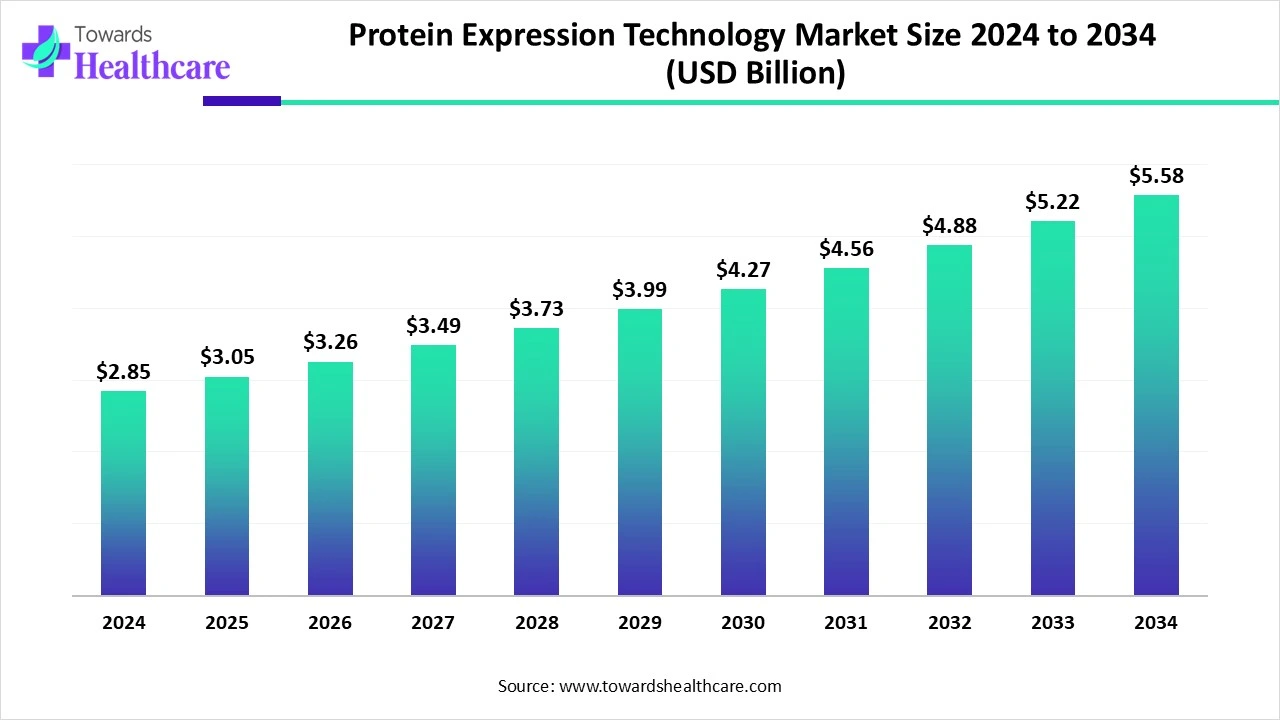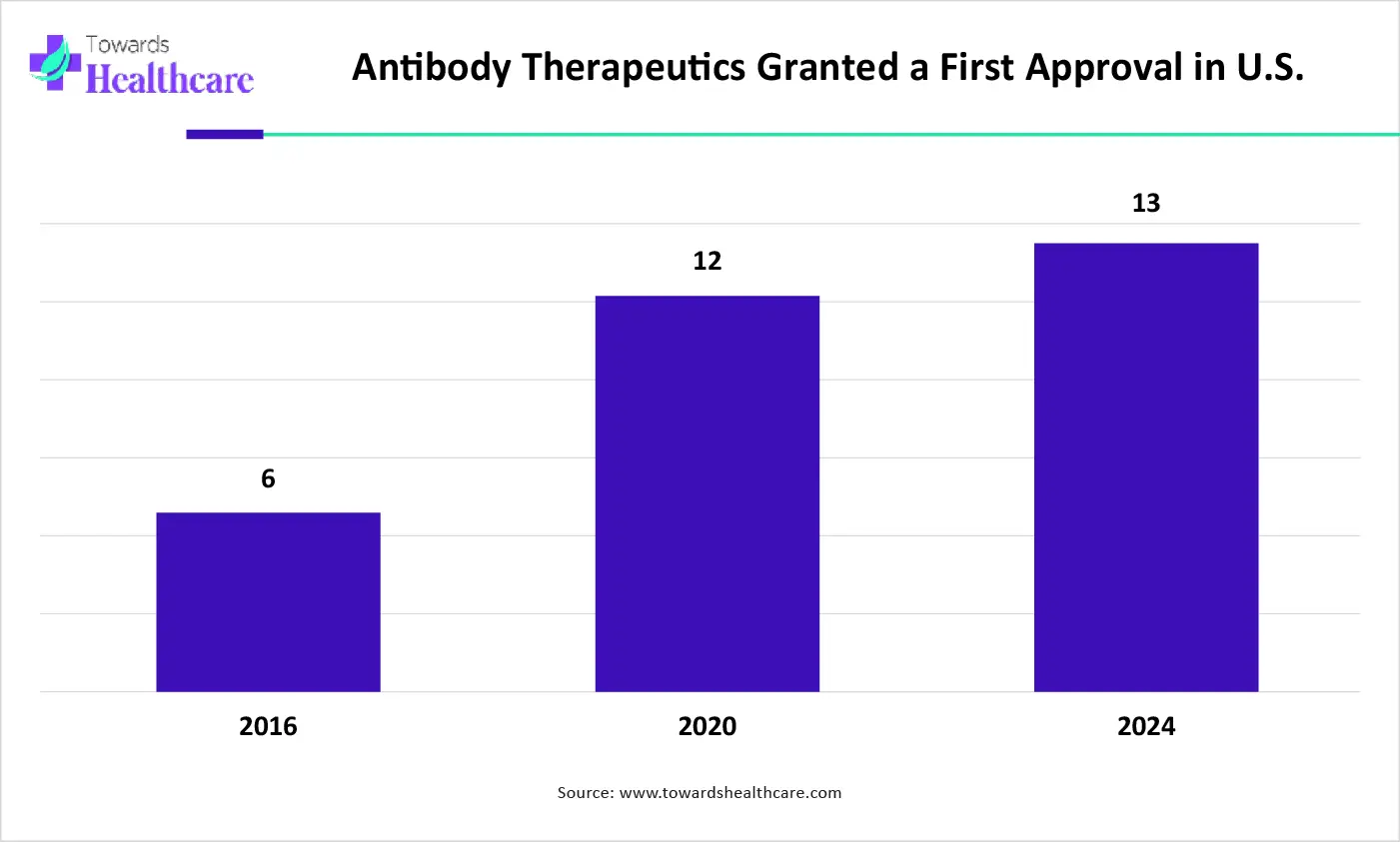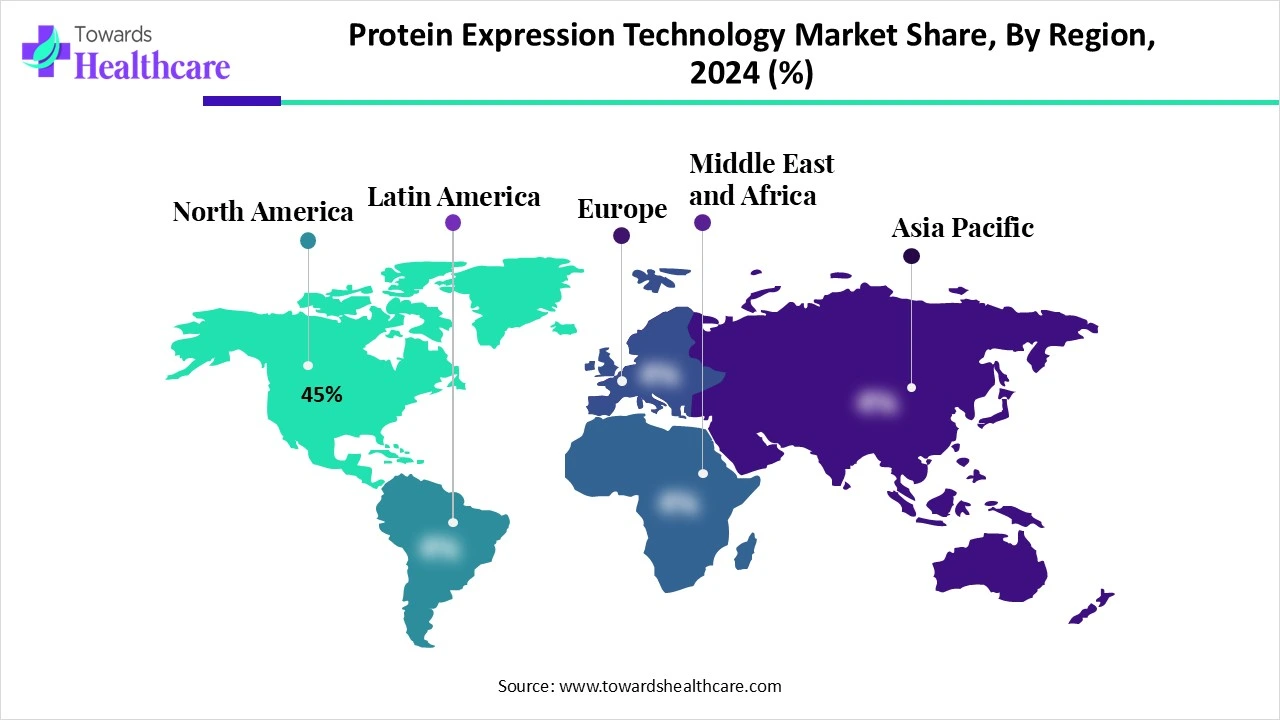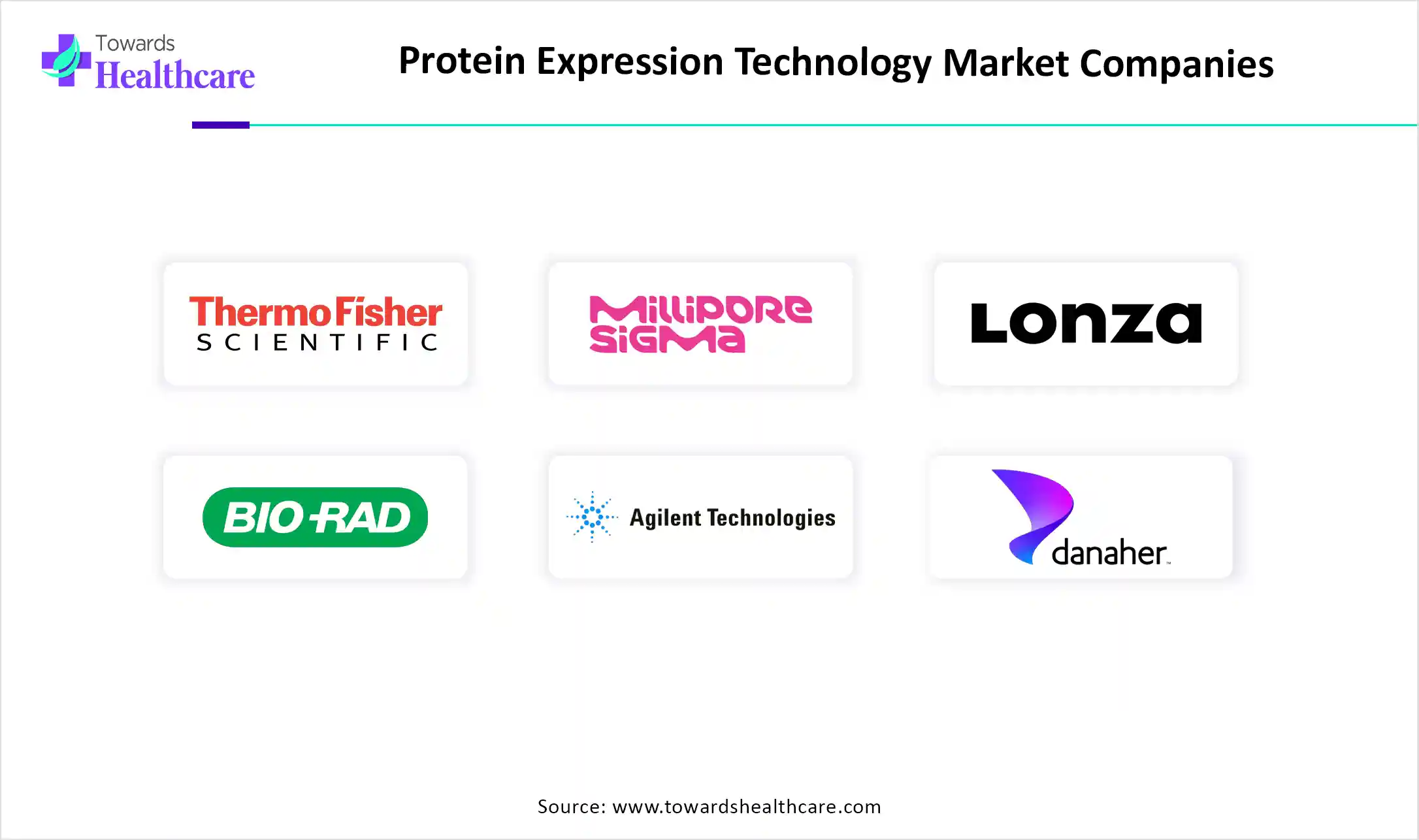November 2025

The global protein expression technology market size is calculated at USD 2.85 in 2024, grew to USD 3.05 billion in 2025, and is projected to reach around USD 5.58 billion by 2034. The market is expanding at a CAGR of 6.94% between 2025 and 2034.

The growing diseases and the development of various treatment approaches are increasing the use of protein expression technology. At the same time, its workflow is being enhanced with the integration of AI. Moreover, new collaborations are being formed, increasing its use for developing and launching new treatment approaches. The use of this expression technology in different regions is also growing due to the robust and expanding industries, along with the growing demand for biologics. Thus, all these developments are promoting the market growth.
| Metric | Details |
| Market Size in 2025 | USD 3.05 Billion |
| Projected Market Size in 2034 | USD 5.58 Billion |
| CAGR (2025 - 2034) | 6.94% |
| Leading Region | North America share by 45% |
| Market Segmentation | By Expression System, By Product Type, By Application, By End Use, By Region |
| Top Key Players | Thermo Fisher Scientific Inc., Merck KGaA (MilliporeSigma), Lonza Group AG, Bio-Rad Laboratories, Inc., Agilent Technologies, Inc., Danaher Corporation, GE Healthcare (Cytiva), Promega Corporation, Qiagen N.V., Novoprotein Scientific Inc., Sino Biological Inc., GenScript Biotech Corporation, Proteintech Group, Takara Bio Inc., Jena Bioscience GmbH, Creative Biolabs, Abcam plc, Pierce Biotechnology (part of Thermo Fisher), LakePharma, Inc., Sutro Biopharma, Inc. |
The protein expression technology market comprises technologies, platforms, and services used to produce proteins-either recombinant or natural-for various applications in research, pharmaceuticals, diagnostics, and industrial biotechnology. These technologies include systems and methods for expressing proteins in host cells like bacteria, yeast, insect, or mammalian cells, enabling the production of proteins for therapeutic drugs, vaccines, enzyme production, and scientific research. Moreover, due to their flexible nature, they provide a wide range of biotechnological applications, innovative treatments, and advantages over conventional expression systems with enhanced efficiency.
The use of AI in protein expression technology is increasing as it helps in predicting the protein structure and minimizes the errors associated with it. At the same time, it effectively analyses a large volume of data, which in turn helps to optimize and enhance the protein expression. Moreover, AI and machine learning help in the identification and detection of protein, accelerating the development process. This, in turn, enhances the production and yield of the products. Similarly, with the help of AI, the purity, safety, stability, and efficacy of the proteins produced can be maintained.
Growing use of Biopharmaceuticals
The growing incidence of chronic diseases is increasing the demand for biopharmaceuticals, which in turn, increases the use of protein expression technology for enhancing the development of high-quality proteins. At the same time growing development of biologics and personalized medications is also increasing their use to increase the production of the proteins required. Moreover, due to its flexible and reliable production of high-quality proteins, it is also being used in the development of advanced therapies. Thus, this drives the protein expression technology market growth.
High Cost
For using the protein expression technology, advanced equipment, chromatographic techniques, and infrastructure are required, which may be costly. Furthermore, it may provide a low yield of the products, resulting in repetitive procedures and delayed clinical trials and approval. Thus, these drawbacks affect the development of products, their affordability, and the accessibility of this technology.
Increasing Advancements in Therapeutic Antibodies
There is a rise in the demand for the use of therapeutic antibodies in the treatment of various diseases. This, in turn, is increasing the demand for the use of protein expression technology. Due to their complex structure, this technology is essential for amplifying the development of the required proteins. At the same time, various antibody therapies and antibody-drug conjugates are also being developed depending on the patient's genetic profiles, enhancing their use. Thus, all these factors are promoting the protein expression technology market growth.
For instance,

The graph represents a comparison between the total number of antibody therapeutics that were granted a first approval in the U.S. It indicates that there is a rise in the approval rates of antibody therapeutics. Hence, it increases the demand for protein expression technology to enhance the development and production of these antibodies. Thus, this in turn will ultimately promote the market growth.
By expression system type, the bacterial expression systems segment led the market with 35% in 2024. The bacterial expression systems provided rapid production of proteins with increased yields. Moreover, it was widely used in the production of enzymes, in research, and in diagnostics. This resulted in market growth.
By expression system type, the mammalian cell expression systems segment is expected to show the fastest growth rate at a notable CAGR during the upcoming years. The use of mammalian cell expression systems in the production of complex proteins is increasing. Similarly, it is also used in the development of biologics, therapeutic proteins, and vaccines.
By product type, the recombinant proteins segment held the largest share of 50% in 2024. The recombinant proteins were used for various purposes in the development of vaccines, antibodies, advanced therapies, etc. Moreover, it also provides large-scale production with enhanced stability of proteins. This contributed to the market growth.
By product type, the antibodies segment is expected to show the fastest growth rate during the predicted time. The use of antibodies is increasing as they are being used in the treatment of various chronic diseases. At the same time, they are also used in the development of personalized treatment approaches, antibody-drug conjugates, biosimilars, etc.
By application type, the pharmaceuticals & biopharmaceuticals segment led the market with 45% in 2024. The pharmaceuticals & biopharmaceuticals contributed to the increased development and manufacturing of various protein-based treatment approaches. Moreover, the increased use of protein expression technology has also increased in research and development. This enhanced the market growth.
By application type, the diagnostics segment is expected to show the highest growth during the upcoming years. The use of diagnostics is increasing for early and accurate detection of growing diseases. Thus, various diagnostic kits or tools are being developed and commercialized with the use of protein expression technology.
By end user, the biotechnology & pharmaceutical companies segment held the largest share in the global market with 55% in 2024. The protein expression technology was mostly used in the biotechnology & pharmaceutical companies to produce a wide range of protein-based treatment approaches. These were also supported by collaborations and investments, promoting the market growth.
By end user, the academic & research institutes segment is expected to show the highest growth during the predicted time. The increasing research and development in the academic & research institutes is driving the demand for protein expression technology. Moreover, these developments are also supported by the government funding, which helps to make technology more accessible.

North America dominated the protein expression technology market share by 45% in 2024. The presence of advanced pharmaceutical and biotechnological industries in North America increased the use of protein expression technology for developing various treatment approaches. Thus, this contributed to the market growth.
The U.S. consists of well-developed industries with the presence of skilled personnel and advanced technologies. At the same time, growing research and development in these industries, along with some institutes for developing new protein-based treatment approaches, is increasing the use and adoption of protein expression technology.
The growing use of biologics in Canada is increasing the use of protein expression technology. This, in turn, is leading to new collaboration among the companies. Moreover, the growing innovations are being supported by the investment provided by the industries as well as the government.
Asia Pacific is expected to host the fastest-growing protein expression technology market during the forecast period. The industries in Asia Pacific are advancing due to growing research and development, adoption of advanced technologies, and investments. Thus, this increases the adoption and use of protein expression technology, enhancing the market growth.
The industries in China are utilizing various advanced technologies, including protein expression technology, to meet the rising demand for the use of biologics. At the same time, new initiatives are also being introduced by the government to enhance the funding and development of these approaches, leveraging protein expression technology.
The expanding industries in India are adopting protein expression technology for the development of various treatment approaches. At the same time, growing research and development and diseases are driving the production of various recombinant proteins, therapeutic antibodies, and increasing the use of protein expression technology.
Europe is expected to grow significantly in the protein expression technology market during the forecast period. Europe consists of robust industries and well-developed institutions, which in turn are focusing on developing novel biologics with the use of protein expression technology. This, in turn, promotes the market growth.
Germany consists of diverse industries as well as startups that are utilizing protein expression technology to enhance the development and production of biologics or biosimilars. Moreover, the growing use of antibodies is also driving their use to develop high-quality proteins. Additionally, the CDMOs are also adopting this technology to enhance the manufacturing of biologics.
The rising occurrence of diseases in the UK is increasing the demand for new treatment approaches. This leads to increased use of protein expression technology in the development of advanced therapies, vaccines, or biologics. Furthermore, the growing research and development also contribute to the same. These are also supported by the investment provided by the government.
The Middle East & Africa region is considered to be a significantly growing area in the protein expression technology market, due to the burgeoning biotechnology sector and the presence of key players. Government organizations launch initiatives to develop and deploy advanced techniques to revolutionize the generation of personalized medicines. The growing research activities and increasing R&D investments contribute to market growth. People are becoming aware of screening and early diagnosis of chronic disorders.
Companies like Biosynth, Sino Biological, and Promega Corporation have a strong presence in the UAE that provides protein expression and protein engineering services to manufacture customized proteins and recombinant proteins & enzymes. The UAE government’s “Emirati Genome Programme” aims to explore the genetic makeup of Emiratis.
Cape Biologix, BioTech Africa, and Fluorobiotech offer a variety of protein expression platforms or services to pharma & biotech companies in South Africa. Proteomics is becoming a cornerstone in medical research, agriculture, environmental studies, and biotech innovation in South Africa.

By Expression System
By Product Type
By Application
By End Use
By Region
November 2025
October 2025
December 2025
November 2025